|
The Internet is a powerful resource. It provides us instant
access to information, and brings us together via email,
bulletin boards, chat rooms, and instant messaging. FAOL
is a wonderful example of the Internet at its best. The Internet,
however, will never replace the printed page.
I've loved books and fishing since my youngest years, although
I did not start fly fishing until 1993. This column will give
me an opportunity to share reviews of some of my favorite fly
fishing and tying books (and some that are not such favorites)
with my friends here at FAOL. My library reflects my tastes
and interests, and so will this column. It will be heavily
slanted towards cold water fishing and tying for trout and
steelhead, and won't touch much on areas of which I know little,
such as warm or salt water fishing.
I hope that these reviews will motivate some of you to pick up
a good book, on this or any subject, and read.
~ Stu Farnham
Three by Doug Swisher and Carl Richards
Selective Trout (30th Anniversary Edition)
Hardcover - 240 pages 2nd Rev&ex edition (April 2001)
Dimensions (in inches): 0.87 x 11.17 x 8.81
The Lyons Press
ISBN: 1585740381
Emergers
Paperback (September 1997)
Dimensions (in inches): 0.38 x 10.95 x 8.50
The Lyons Press
ISBN: 1558216588
Tying the Swisher/Richards Flies
Paperback (February 1980)
Stackpole Books
ISBN: 0811720993
Out of Print
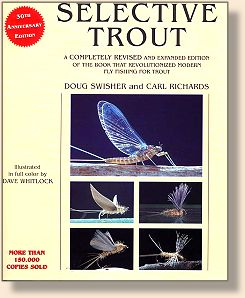 There was a revolution afoot in North American fly tying and
fishing. If Ernest Schwiebert was the Thomas Paine of this
revolution, with his 1957 book Matching the Hatch,
Doug Swisher and Carl Richards were its Benjamin Franklin and
Thomas Jefferson. In 1971 they published Selective Trout,
a book which applied solid field entomology to fly fishing.
The book was reissued in a revised and expanded 3oth anniversary
edition in 2000.
There was a revolution afoot in North American fly tying and
fishing. If Ernest Schwiebert was the Thomas Paine of this
revolution, with his 1957 book Matching the Hatch,
Doug Swisher and Carl Richards were its Benjamin Franklin and
Thomas Jefferson. In 1971 they published Selective Trout,
a book which applied solid field entomology to fly fishing.
The book was reissued in a revised and expanded 3oth anniversary
edition in 2000.
Swisher and Richards present the core of their manifesto in chapter
three, 'The Need for Realistic Imitation.' As human population and
fishing pressure grew, catch and release came into common practice,
and continued exploitation of the fisheries in the form of over
harvesting took its toll, the techniques and flies which had been
sufficient in the past were meeting with less and less success.
While it is still true today that, on any given day, there is
probably at least one trout who'll take whatever is offered,
it was increasingly hard to take fish using the lure and
attractor patterns of the past.
Other early chapters describe procedures for collecting, identifying,
and photographing aquatic insects. Chapter four applies the
observations made using these procedures to fly tying, and
introduces the now-familiar no hackle and paradun patterns.
Perhaps more important overall was the emphasis placed on
emerger, stillborn (cripple), and spinner forms.
There's a large portion of the book dedicated to a seasonal
presentation of mayfly species and their imitation, and chapters
on caddis flies and terrestrials. They then go on to develop the
concept of 'super hatches,' the handful of hatches which dominate
in any given part of the country, and suggest imitations of each.
There's a short chapter on night fishing (of little interest to me
because it is prohibited here in Oregon), and appendices presenting
keys to identification of mayflies and caddis flies for the
would-be entomologists among us.
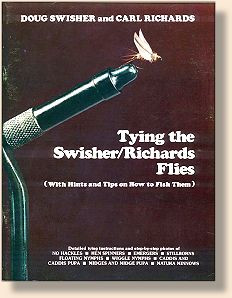
While Selective Trout described a group of new
patterns, it did not include detailed tying instructions. These
were presented in the 1977 book Tying the Swisher/Richards
Flies (originally printed by P.Y. Dylan & Co., and reissued
by Stackpole Books in 1980). This book has detailed instructions
on tying no-hackles, paradrakes, spinners, wiggle nymphs, and more,
and features flies tied by the authors and by Rene Harrop. The thing
that strikes me as I look at my copy of the 1977 edition is how
lucky we are today to have instruction books like those by Skip
Morris, Randall Kaufmann, Jim Schollmeyer and Ted Leeson, and
others. The black and white photographs in this book are murky
and the detail is hard to see. Nonetheless, the accompanying
text is detailed and useful, and this book makes a good companion
to Selective Trout for the fly tier.
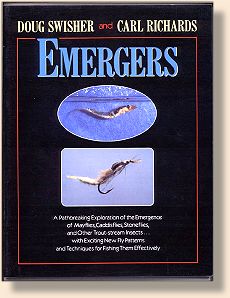 In their 1991 book Emergers, Swisher and Richards
focus in on what is probably the most vulnerable stage of the
aquatic insects' life cycle. Wonderful photographs (mostly black
and white, unfortunately) show the emergence of various mayflies
and caddis. There are chapters which describe behavioral drift
and the factors effecting successful emergence. I know from first
hand experience that emergers fish better than duns for baetis
hatches that occur in cold, damp weather because the insects have
a harder time successfully escaping the surface film.
In their 1991 book Emergers, Swisher and Richards
focus in on what is probably the most vulnerable stage of the
aquatic insects' life cycle. Wonderful photographs (mostly black
and white, unfortunately) show the emergence of various mayflies
and caddis. There are chapters which describe behavioral drift
and the factors effecting successful emergence. I know from first
hand experience that emergers fish better than duns for baetis
hatches that occur in cold, damp weather because the insects have
a harder time successfully escaping the surface film.
An extensive section of patterns includes what may be the first
extensive treatment of the use of CDC (call 'duck butt' in this
book) in North American fly angling literature. The book closes
with a chapter on surface fishing techniques which will be familiar
to anyone who has read Swisher's & Richard's Fly Fishing Strategy
or seen the wonderful series of videos Doug made with Scientific
Anglers.
I can't close a discussion of these books without mentioning the
artwork contributed by Dave Whitlock. His fine pen and ink work
removes distracting detail while keeping a realistic and lifelike
appearance. His fly renderings, especially the colored versions
in Selective Trout are sufficiently clear and detailed
to tie from. ~ Stu Farnham
About Stu
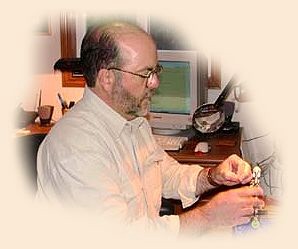 Stu Farnham is a New Englander by birth, who was transplanted to
and put down roots in Oregon in the early 1990s. A software
engineering manager by vocation, he can be found in his spare
time chasing trout and steelhead in the rivers of the Pacific
Northwest, chasing his four Gordon Setters (who in turn are
chasing chukar), tying flies, reading, or working on his website.
Colleen, his long suffering wife of 28 years, is a professionally
trained personal chef.
Stu Farnham is a New Englander by birth, who was transplanted to
and put down roots in Oregon in the early 1990s. A software
engineering manager by vocation, he can be found in his spare
time chasing trout and steelhead in the rivers of the Pacific
Northwest, chasing his four Gordon Setters (who in turn are
chasing chukar), tying flies, reading, or working on his website.
Colleen, his long suffering wife of 28 years, is a professionally
trained personal chef.
|
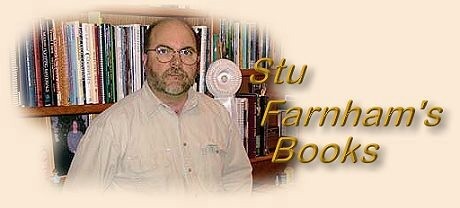
 Stu Farnham is a New Englander by birth, who was transplanted to
and put down roots in Oregon in the early 1990s. A software
engineering manager by vocation, he can be found in his spare
time chasing trout and steelhead in the rivers of the Pacific
Northwest, chasing his four Gordon Setters (who in turn are
chasing chukar), tying flies, reading, or working on his website.
Colleen, his long suffering wife of 28 years, is a professionally
trained personal chef.
Stu Farnham is a New Englander by birth, who was transplanted to
and put down roots in Oregon in the early 1990s. A software
engineering manager by vocation, he can be found in his spare
time chasing trout and steelhead in the rivers of the Pacific
Northwest, chasing his four Gordon Setters (who in turn are
chasing chukar), tying flies, reading, or working on his website.
Colleen, his long suffering wife of 28 years, is a professionally
trained personal chef.
 There was a revolution afoot in North American fly tying and
fishing. If Ernest Schwiebert was the Thomas Paine of this
revolution, with his 1957 book Matching the Hatch,
Doug Swisher and Carl Richards were its Benjamin Franklin and
Thomas Jefferson. In 1971 they published Selective Trout,
a book which applied solid field entomology to fly fishing.
The book was reissued in a revised and expanded 3oth anniversary
edition in 2000.
There was a revolution afoot in North American fly tying and
fishing. If Ernest Schwiebert was the Thomas Paine of this
revolution, with his 1957 book Matching the Hatch,
Doug Swisher and Carl Richards were its Benjamin Franklin and
Thomas Jefferson. In 1971 they published Selective Trout,
a book which applied solid field entomology to fly fishing.
The book was reissued in a revised and expanded 3oth anniversary
edition in 2000.
 In their 1991 book Emergers, Swisher and Richards
focus in on what is probably the most vulnerable stage of the
aquatic insects' life cycle. Wonderful photographs (mostly black
and white, unfortunately) show the emergence of various mayflies
and caddis. There are chapters which describe behavioral drift
and the factors effecting successful emergence. I know from first
hand experience that emergers fish better than duns for baetis
hatches that occur in cold, damp weather because the insects have
a harder time successfully escaping the surface film.
In their 1991 book Emergers, Swisher and Richards
focus in on what is probably the most vulnerable stage of the
aquatic insects' life cycle. Wonderful photographs (mostly black
and white, unfortunately) show the emergence of various mayflies
and caddis. There are chapters which describe behavioral drift
and the factors effecting successful emergence. I know from first
hand experience that emergers fish better than duns for baetis
hatches that occur in cold, damp weather because the insects have
a harder time successfully escaping the surface film.